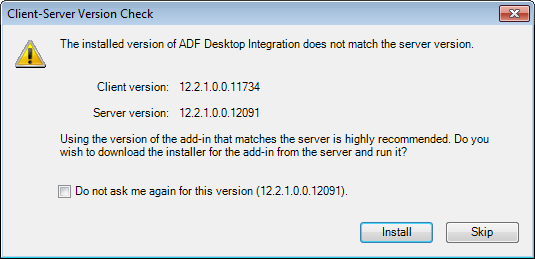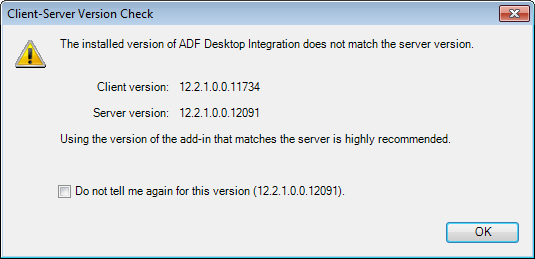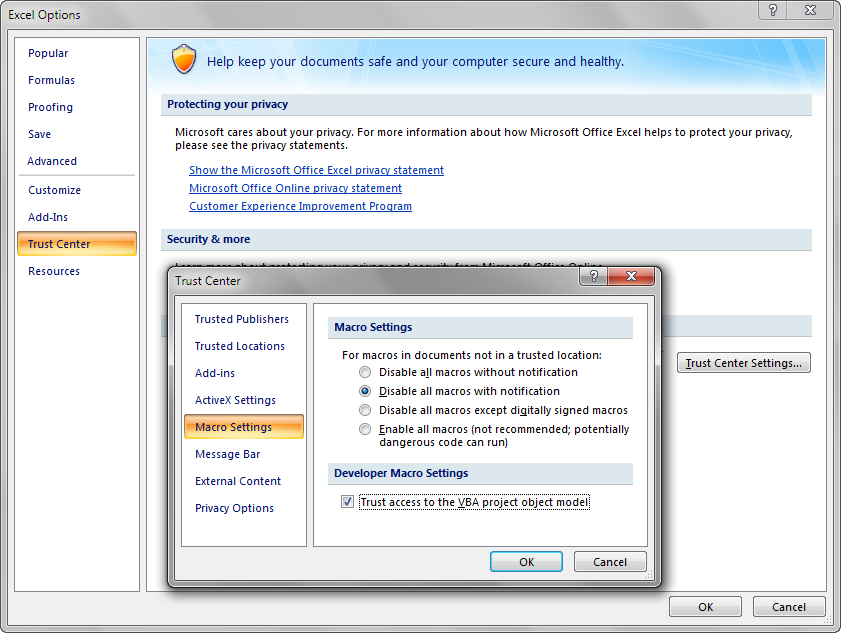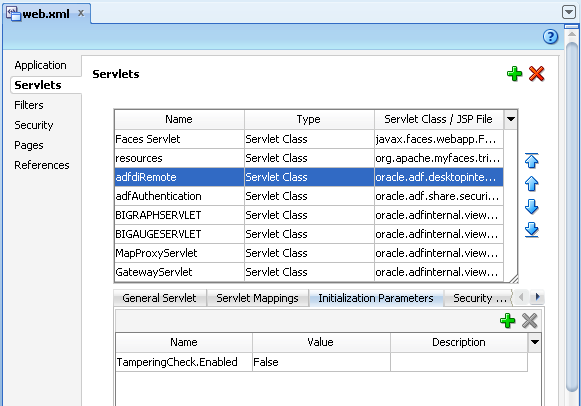5 Administering ADF Desktop Integration
Note that before an end user can use the integrated Excel workbook, the ADF Desktop Integration add-in must be installed on the end user's system.
This chapter includes the following sections:
5.1 Installing and Upgrading ADF Desktop Integration
You can make the ADF Desktop Integration installer available to end users to install, as described in How to Install the ADF Desktop Integration Add-in From a Web Server. Alternatively, you can install it, as described in the "Installing ADF Desktop Integration" section of the Developing Applications with Oracle ADF Desktop Integration.
Note:
Installation of the ADF Desktop Integration add-in is specific to the current Windows user profile. If you have multiple Windows user profiles on a system, and you want to use ADF Desktop Integration integrated Excel workbooks in more than one of these user profiles, you must log in to each user profile and install the ADF Desktop Integration add-in.
When the ADF Desktop Integration installer runs, it verifies whether the required software is installed on the system. For more information about the required software, see the Prerequisites for Installing ADF Desktop Integration Add-in. In addition to installing the ADF Desktop Integration add-in, you (or the end user) must configure Microsoft Excel settings to make Excel accessible from ADF Desktop Integration, as described in Configuring the End User's Microsoft Excel to work with ADF Desktop Integration.
5.1.1 Prerequisites for Installing ADF Desktop Integration Add-in
Before you install the ADF Desktop Integration add-in, make sure that you have the required Oracle ADF modules and third-party software installed and configured:
Microsoft Windows
Microsoft Windows operating systems support the development and deployment of Excel workbooks that integrate with Fusion web applications. For more information about supported versions of Windows, see the "Oracle JDeveloper and Application Development Framework Certification Information" page on OTN at:
http://www.oracle.com/technetwork/developer-tools/jdev/documentation/jdev-088164.htmlMicrosoft Excel
For information about supported versions of Excel, see the "Oracle JDeveloper and Application Development Framework Certification Information" page on OTN at:
http://www.oracle.com/technetwork/developer-tools/jdev/documentation/jdev-088164.htmlInternet Explorer
Some features in ADF Desktop Integration use a web browser control from the Microsoft .NET Framework. This browser control relies on the local Internet Explorer installation to function properly.
ADF Desktop Integration uses Internet Explorer to render web pages inside Excel, regardless of other browsers installed on the system or any other browser set as the default browser.
The following software is required before ADF Desktop Integration add-in is installed. If this software is missing, the ADF Desktop Integration installer automatically downloads and installs it before installing the ADF Desktop Integration add-in.
Microsoft .NET Framework 4.5.2
The Microsoft .NET Framework 4.5.2 provides the runtime and associated files required to run applications developed to target the Microsoft .NET Framework. You can download the framework from
http://www.microsoft.com/download/.Microsoft Visual Studio 2010 Tools for Office Runtime
The Microsoft Visual Studio 2010 Tools for Office Runtime (Version 4) is required to run VSTO solutions for the Microsoft Office system. You can download the Microsoft Visual Studio 2010 Tools for Office Runtime from
http://www.microsoft.com/download/.
5.1.2 Configuring the End User's Microsoft Excel to work with ADF Desktop Integration
Perform the following procedure once if the integrated Excel workbook(s) that end users will use contain ADF Button components.
To allow Excel to run an integrated Excel workbook:
5.1.3 How to Install the ADF Desktop Integration Add-in From a Web Server
You can make the ADF Desktop Integration installer available from the web server where your Fusion web application is running. The installer is embedded in the oracle.adf.desktopintegration.war file and can be downloaded by the end user from the ADF Desktop Integration-enabled Fusion web application.
To download the installer from a web server:
Note:
Making the ADF Desktop Integration add-in installer available for download only works if the Fusion web application is an ADF Desktop Integration-enabled Fusion web application. The developer of a Fusion web application can implicitly enable ADF Desktop Integration by adding an integrated Excel workbook to the Fusion web application, as described in the "Adding an Integrated Excel Workbook to a Fusion Web Application" section, or explicitly, by configuring the application's web.xml file, as described in the "ADF Desktop Integration Settings in the Web Application Deployment Descriptor" appendix in Developing Applications with Oracle ADF Desktop Integration. Adding an integrated Excel workbook to the Fusion web application may be preferable to configuring the web.xml file directly because JDeveloper makes many of the required configuration changes when the developer adds an integrated Excel workbook to the Fusion web application.
5.1.4 How to Upgrade the ADF Desktop Integration Add-in
An end user can upgrade ADF Desktop Integration in two ways.
Run the ADF Desktop Integration installer to upgrade.
For more information about downloading the installer, see How to Install the ADF Desktop Integration Add-in From a Web Server.
Open and run the integrated Excel workbook.
Each time the end user logs into the Fusion web application from an integrated Excel workbook, ADF Desktop Integration checks whether the version installed on the client matches the version on the server. If the versions do not match, the end user will be prompted to download the latest version of ADF Desktop Integration. If the end user accepts the prompt to install the latest version, the end user must also restart the Excel application after the installation completes for the change to take effect. For more information, see Verifying the Client Version of ADF Desktop Integration.
5.1.5 How to Run ADF Desktop Integration Installer from Command Line
The ADF Desktop Integration installer also supports command line options. Table 5-1 lists switches that you can specify with the installer executable file.
Table 5-1 ADF Desktop Integration Installer Command Line Switches
| Switch | Description |
|---|---|
|
Displays a list of supported switches with description. |
|
Suppresses the interactive mode of the installer and does not install any missing prerequisite software. Before you install ADF Desktop Integration using the quiet mode, make sure that prerequisite software is installed on the end user's system. For more information about prerequisite software, see Prerequisites for Installing ADF Desktop Integration Add-in. |
|
Installs the add-in with designer tools enabled. Application developers use the designer tools to configure integrated Excel workbooks. The designer tools are not intended for end users. For this reason, do not enable designer tools if installing the ADF Desktop Integration add-in for end users. By default, the ADF Desktop Integration add-in for end users is installed with designer tools disabled unless enabled during a previous installation. You can install the ADF Desktop Integration add-in for end users with designer tools disabled using the following switch: /designer 0 |
|
Runs the installer and directs the log output to the specified log file. |
5.2 ADF Desktop Integration Logs
ADF Desktop Integration generates log files during installation and in response to various client and server events.
Installation Log File
The default location of the ADF Desktop Integration installation log file is %TEMP%\adfdi-installer-log.txt. For example, C:\Users\UserID\AppData\Local\Temp\adfdi-installer-log.txt. You can redirect the location of the install log file using the /log <path> command-line switch described in How to Run ADF Desktop Integration Installer from Command Line.
Server-side Log Files
You configure the generation of server-side log files for ADF Desktop Integration the same way as for other Oracle ADF modules. For more information, see the "About Server-Side Logging" section in Developing Applications with Oracle ADF Desktop Integration. You can also use the Oracle Diagnostics Log Analyzer to view a hierarchical breakdown of elapsed time spent performing each ADF Desktop Integration servlet request. For more information, see the "Using the Oracle Diagnostics Log Analyzer to Analyze ADF Desktop Integration Servlet Requests" section in Developing Applications with Oracle ADF Desktop Integration.
Client-side Log File
For information about client-side log files, see the "About Client-Side Logging" section in Developing Applications with Oracle ADF Desktop Integration.
For more general information about logging in an Oracle Fusion Middleware environment, see the "Managing Log Files and Diagnostic Data" chapter in Administering Oracle Fusion Middleware.
5.3 Security in ADF Desktop Integration
If your Fusion web application enforces authentication, the integrated Excel workbooks also make sure that an authenticated end user session is established before data transfer happens between the workbooks and application. For more information, see the "About Security In Your Integrated Excel Workbook" section in Developing Applications with Oracle ADF Desktop Integration.
5.3.1 End User Authentication
If end users are not prompted for user credentials while using integrated Excel workbooks and interacting with a secure Fusion web application, you need to investigate the security configuration of the Fusion web application. For more information, see the "Verifying End-User Authentication for Integrated Excel Workbooks" section in Developing Applications with Oracle ADF Desktop Integration.
For more information about ADF Desktop Integration security, see the "Oracle ADF Desktop Integration Security whitepaper" on OTN at:
http://www.oracle.com/technetwork/developer-tools/adf/overview/index-085534.html
5.3.2 What You May Need to Know About Configuring Security in a Fusion Web Application
Note the following points before you secure your application:
For applications running in an environment using Oracle Access Manager, the system administrator should make sure that the URL for the ADF Desktop Integration Remote servlet is configured as a protected resource for Oracle Access Manager.
For more information, see the Oracle Fusion Middleware Administrator's Guide for Oracle Access Management.
For applications running in an environment using WebGate 11g, set the user-defined parameter
filterOAMAuthnCookietoFalse.For more information, see the chapter on registering partners (agents and applications) remotely in Oracle Fusion Middleware Administrator's Guide for Oracle Access Management.
Make sure that applications using ADF Desktop Integration have a security constraint configured in
web.xmlthat protects the ADF Desktop Integration remote servlet.The following code extract from
web.xmlshows an example security constraint protecting the remote servlet:<security-constraint> <web-resource-collection> <web-resource-name>adfdiRemote</web-resource-name> <url-pattern>/adfdiRemoteServlet</url-pattern> </web-resource-collection> <auth-constraint> <role-name>valid-users</role-name> </auth-constraint> </security-constraint>When using Oracle WebGate and a SSL URL to access the Fusion web application (such as
https:// ...) it may be necessary to configure WebGate'smod_wl_ohs.confconfiguration file as follows:<IfModule mod_weblogic.c> WLProxySSLPassThrough ON WLProxySSL ON MatchExpression /TestApp WebLogicHost=test.host.com|WebLogicPort=7101| </IfModule>
where
/TestAppis the context root of your application,test.host.comis the host name and domain, and7101is the port number for the web application.When opening an integrated Excel workbook, or any Microsoft Office document, directly (without downloading the file) from a link in the Fusion web application, the Windows Login dialog may appear twice asking for user credentials. This happens because Microsoft Office sends its own authentication request to the web server, making the Login dialog appear twice. End users may click Cancel and ignore the first authentication request.
Applications secured via a digital certificate where clients use
httpsURLs to access the application should make sure that the certificate is valid. Valid certificates have host names that match the host to which they are deployed, have not expired, and have a valid path to a trusted issuing authority. In the case where the certificate is invalid, the client will be prompted during login to accept the invalid certificate.ADF uses chunked encoding for some requests to the server. If you have any network devices between Excel and the web application server configured to block requests that do not contain a content length header, you should configure them to allow chunked encoding (no content length header). Some network devices such as content caching servers may have a default configuration that blocks requests with no content length header.
For more information about securing integrated Excel workbooks, see the "What You May Need to Know About Securing an Integrated Excel Workbook" section in Developing Applications with Oracle ADF Desktop Integration.
5.3.3 What You May Need to Know About Resource Grants for Web Pages
In an integrated Excel workbook, each worksheet is bound to a specific page definition. Users' access to pages may be controlled by resource grants. If an end user is not authorized to work with a page definition, ADF Desktop Integration disallows all data transactions in worksheets bound to that page definition, displays a failure message, and disables those integrated worksheets. The end user can alter any existing data in the worksheet, but cannot download or upload it. The tracking of changes in ADF Table components is also disabled. The end user can continue to use ADF Desktop Integration features in other worksheets in the same workbook, provided those worksheets are bound to page definitions that the end user is authorized to work with.
The worksheet is re-enabled when the end user reopens the workbook and establishes a new session, provided that the end user has obtained the necessary resource grants for the corresponding page definition.
For more information about securing your Fusion web application, see the "Enabling ADF Security in a Fusion Web Application" chapter in Developing Fusion Web Applications with Oracle Application Development Framework.
5.4 Verifying the Client Version of ADF Desktop Integration
ADF Desktop Integration verifies whether the client and the server versions match each time that an end user establishes a session with the Fusion web application from the runtime integrated Excel workbook. If the versions do not match, ADF Desktop Integration displays the dialog shown in Figure 5-2. If the versions match, no dialog appears to the end users.
Figure 5-2 Client-Server Version Check Dialog

If the end user clicks:
Install: ADF Desktop Integration initiates the download of the installer from the server to update the client to the matching server version
Skip and selects the Do not ask me again for this version… checkbox: ADF Desktop Integration attempts to continue to function normally. No dialog appears on later occasions when the end user connects to the same version of the Fusion web application from the integrated Excel workbook.
Always using a client version that matches the server version is highly recommended to avoid unexpected behavior or errors. If end users choose either of the options that skip the installation of a newer client version of ADF Desktop Integration, they can install at a later time by clicking the Check for updates link that appears in the About dialog of the integrated Excel workbook, as shown in Figure 5-3.
Figure 5-3 Check for Updates Link for End Users

For scenarios where you do not want end users to install a newer client version or they cannot because they do not have the required privileges to install software on their machines, the default behavior where ADF Desktop Integration displays an option to install a newer version can be disabled. When you disable the option to install a newer client version, the Client-Server Version Check dialog appears and informs the end user of the mismatch, but does not present an option to install a newer version. Figure 5-4 shows this dialog. Furthermore, the About dialog shown in Figure 5-3 will no longer have a Check for updates link to start an install process. For more information about how to disable the option to upgrade, see How to Disable the Install Option on the Client-Server Version Check Dialog.
Figure 5-4 Client-Server Version Check Dialog without Install Option

Note that:
ADF Desktop Integration performs the client-server version verification every time that the integrated Excel workbook establishes a session with the Fusion web application.
The version of ADF Desktop Integration running on the server can change at any time (for example, server upgrade), but ADF Desktop Integration only performs the client-server version verification when the user session is re-established.
Consider employing other mechanisms for situations where end users cannot install a version that matches the server version. For example, automatically push out software updates from a centrally-managed IT source to make sure that the matching version of the client software is installed.
5.4.1 How to Disable the Install Option on the Client-Server Version Check Dialog
By default, ADF Desktop Integration displays an option to end users to install a newer client version from the Client-Server Version check dialog. You can disable this option so that ADF Desktop Integration informs end users of the mismatch, as shown in Figure 5-4, but does not permit end users to install a newer client version.
Before you begin:
It may be helpful to have an understanding of how ADF Desktop Integration verifies if the client and server versions match. For more information, see Verifying the Client Version of ADF Desktop Integration.
To disable the install option on the Client-Server Version Check dialog:
5.5 Verifying Integrated Excel Workbook Metadata
To give end users the confidence that the workbook configuration has not been altered maliciously, ADF Desktop Integration verifies the integrity of the workbook metadata automatically using the Tamper-Check feature. For more information, see the "Checking the Integrity of an Integrated Excel Workbook's Metadata" section in Developing Applications with Oracle ADF Desktop Integration.
5.5.1 How to Disable the Metadata Tamper-Check in the Fusion Web Application
By default, ADF Desktop Integration verifies that the workbook configuration metadata is not tampered with after the workbook's developer publishes the Excel workbook for end users. You can disable the metadata tamper-check by configuring a parameter in the deployment descriptor file (web.xml) of the Fusion web application.
Before you begin:
It may be helpful to have an understanding of how ADF Desktop Integration verifies the integrity of an integrated Excel workbook's metadata. For more information, see Verifying Integrated Excel Workbook Metadata.
To disable the metadata tamper-check in the Fusion web application:
If the TamperingCheck.Enabled parameter is not present in web.xml, tamper check is enabled. For more information about the web.xml file, see the "ADF Desktop Integration Settings in the Web Application Deployment Descriptor" appendix in Developing Applications with Oracle ADF Desktop Integration.
5.6 Common ADF Desktop Integration Error Messages and Problems
While using or configuring the ADF Desktop Integration-enabled Fusion web application or workbooks, you might see error messages or encounter problems. The following list describes the most common error messages, their causes, and solutions.
See also:
The "Common ADF Desktop Integration Error Messages and Problems" section in Developing Applications with Oracle ADF Desktop Integration.
The "ADFDI-00100 to ADFDI-55516" chapter in Oracle Fusion Middleware Error Messages.
The "Troubleshooting Oracle ADF Desktop Integration" document that you can retrieve from My Oracle Support (
https://support.oracle.com) if you search for Doc ID2012600.2.
- Error message: Access to this web server is disabled because it is controlled by basic authentication and does not use Secure Socket Layer (SSL).
Cause: The user downloads and opens a workbook, published using Microsoft Office 2010, from the Fusion web application secured using basic authentication.
- Error message: UnableToEstablishUnauthenticatedSessionException: ADFDI-00502: The client was unable to establish an unauthenticated session with the web application
Cause: Incorrect security configuration in the Fusion web application.
- Problem: Edit Options dialog appears prompting for WebAppRoot when downloading an integrated Excel workbook from a Fusion web application
Cause: The
adfdiExcelDownloadfilter is not properly configured inweb.xml, and so the filter is not able to set the WebAppRoot property on the downloaded workbook.- Problem: Login window does not close after submitting valid credentials in Oracle Access Manager environment
Cause: The
/myApp/adfdiRemoteServletwas not properly added as a protected resource to the Oracle Access Manager configuration.- Problem:
UserSessionRequiredExceptionon login in Oracle Access Manager environment with WebGate 11g Cause: The user defined parameter
filterOAMAuthnCookieis not set in the WebGate 11g configuration.- Problem: The
DIRemoteServletreturnsInvalid XML: unexpected end of responseerror message Cause: An exception has occurred in the ADF Model code, custom application module, or in the view object.
- Problem: Unable to successfully connect when downloading and opening integrated Excel workbooks in environments using Oracle Weblogic Server with clustering, firewalls, and/or proxy servers.
Cause: The URL embedded into the workbook does not reflect the correct URL in use for the web application. The
adfdiExcelDownloadfilter embeds the URL for the web application that it finds in the request to download the workbook. This URL needs to reflect the correct front end server.

